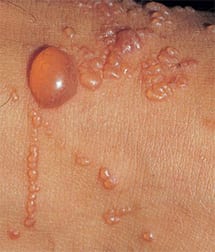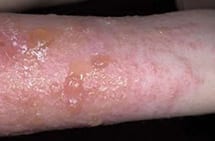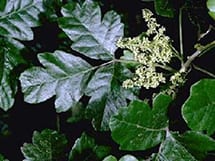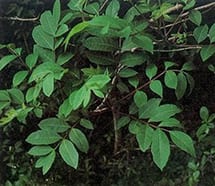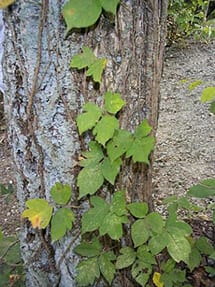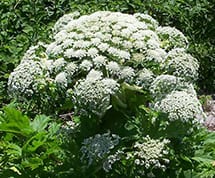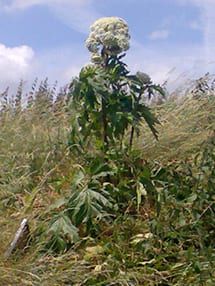Poison Ivy, Poison Oak, Poison Sumac or Giant Hogweed (Contact Dermatitis)
Serving Hamilton, Stoney Creek, Grimsby and surrounding areas
Poison Ivy:
- Poison Ivy is a common plant found in Canada and the United States
- It can be a vine, shrub, bush, or ground cover
- In the Niagara Peninsula it can often be seen by the side of the road growing up telephone poles
- The plant can be recognized by the fact that it has green leaves in groups of three
- An easy saying to remember is: “Leaves of three, Let them be!”
- Some features that may be used to identify poison ivy are:
- The plant stems are woody and can be found growing in two forms
- The most frequent form is a trailing vine, with upright leafy stalks 10 to 80 cm high
- The second kind is an aerial vine that may climb 6 to 10 m high on trees, posts or rough surfaces
- The poison ivy leaf consists of three pointed leaflets, with the middle leaflet having a much longer stalk than the two side ones
- The leaflet itself can be extremely variable in shape, from smooth to toothed edges and varies greatly in size, from 8 to 55 mm in length
- Leaves are reddish when they emerge in the spring, turn green during the summer and become various shades of yellow, orange or red in the autumn
- The plant produces clusters of cream to yellow-green inconspicuous flowers during the months of June and July
- Appearing in September, the berries are clustered, waxy and green to yellow in colour
- The berry ranges in size from 3 to 7 mm in diameter
- Berries often remain on the low, leafless stems of the plant all winter
- The plant stems are woody and can be found growing in two forms
- You can get the rash by touching any part of the plant
- The only way to get poison ivy is to touch the plant, or to touch something that has touched the plant
- An example of the latter occurs when you touch the fur of a dog that has been in poison ivy
- When you touch the plant resin on the animal’s fur, you will develop the rash
- The rash only appears when you touch the plant a second time
- The first time that you touch poison ivy, your body becomes sensitive to it, but, there is no rash
- On the second exposure the rash can be severe with formation of large blisters and intense itching
- The rash may appear as red swollen areas of skin or rows of blisters forming lines
- These are areas where the edges of the leaves of the plant have touched the skin
- You can get the rash at any time of year, even in winter when there are no leaves on the plant
- The rash does no recur every seven years – this is an old wives’ tale
- The only way for the rash to return is if you touch the plant again
- Poison ivy, poison oak, and poison sumac grow almost everywhere in the United States, except Hawaii, Alaska, and some desert areas in the Western U.S.
- Poison ivy usually grows east of the Rocky Mountains and in Canada
- Poison oak grows in the Western United States, Canada, Mexico (western poison oak), and in the Southeastern states (eastern poison oak)
- Poison sumac grows in the Eastern states and southern Canada
Giant Hogweed:
- Is an invasive weed that was introduced to North America for its ornamental value
- It has escaped from gardens and is becoming widespread in Ontario, especially by river beds
- The plant produces a photophotodermatitis – in which contact with the plant, combined with sun exposure may produce a severe blistering rash, similar in appearance to poison ivy contact dermatitis
- Some characteristics that may be used to identify the plant are:
- Very tall plants, 3 to 5 metres in height
- Stems that are 2-4 inches in diameter with rigid hairs, purple blotches and are hollow
- Leaves that are unevenly lobed and up to 1.5 m wide
- Flowers clusters up to 2 feet across occurring from mid June to late July
- Bears a close resemblance to native cow parsley and hogweed
- Has a reddish purple stem with fine spines that make it appear furry (like a stinging nettle)
- Has spotted leaf stalks
- If you must handle this plant be careful not to come into contact with the sap from broken stems
- You should be well covered, wearing gloves, long sleeves and long pants
- Giant Hogweed is a short lived perennial weed that reproduces only by seed and is predominantly found along rivers, streams and wet land areas, but can also be found in pasture land
- If you see giant hogweed, contact the municipality where you live and they should remove it or kill the weed
General Measures:
- These apply to contact dermatitis from most plants, including poison ivy, poison sumac, poison oak and giant hogweed
- Do not take hot baths or showers
- Use only lukewarm or cool water
- If you have many blisters you can use an oatmeal bath powder in the bathtub
- This will help the blisters to dry and help with the itching
- You may break the blisters if they are painful, this will not cause the rash to spread
- Wash all clothing that may have come into contact with the plant
- Bathe any pets that may have come into contact with the plant
- Change seat covers on car seats, or cover the seats, if you think that they may have been contaminated by plant residue on your clothing
- Be very careful when destroying these plants
- It is possible to get the rash from the roots, stems, leaves and berries
- Be especially careful if you burn the plant
- Inhaling the smoke can cause severe inflammation of the lungs and throat and is very dangerous and can be life-threatening
- The rash may continue to appear for 2 to 3 weeks after exposure, even if you do not touch the plant again
- You cannot spread the rash on yourself from the fluid from the blisters
- The rash is not contagious and you cannot give it to other people
Treatment
- A variety of creams and pills are available
- Please discuss your treatment options with your doctor
Typical Linear Lesions of Poison Ivy Contact Dermatitis
Poison Ivy – Arm
Poison Oak
Poison Sumac
Poison Ivy
Giant Hogweed
Giant Hogweed
What if you are interested to learn more?
If you would like to learn more please phone the aesthetic centre directly at (905) 549-7873 to book a free consultation with one of our knowledgeable technicians or

